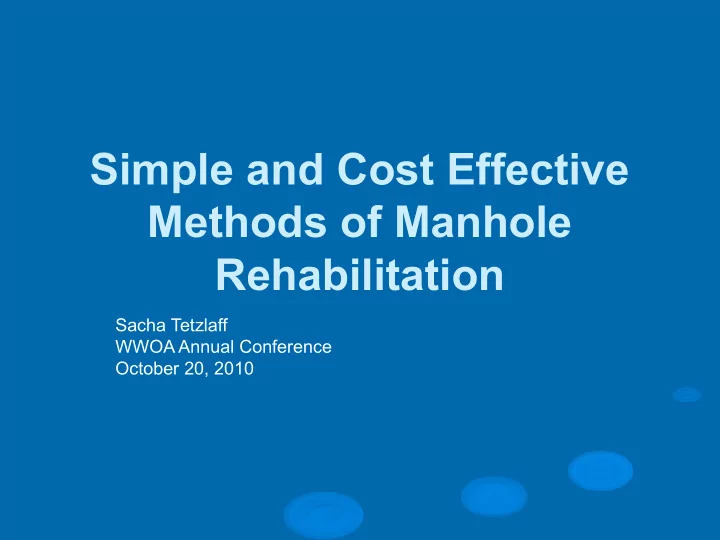

Simple and Cost Effective Methods of Manhole Rehabilitation Sacha Tetzlaff WWOA Annual Conference October 20, 2010
Presentation Overview Ø Why worry about MH I/I and deterioration? Ø Types of Problems Commonly Found Ø Basic or Minor Problems l Simple, cheap and easy fixes Ø Complex or Major Problems l Relatively simple to complex, but more expensive fixes
Budgetary and Capacity Concerns Ø Cost to transport and treat Ø Need bigger more expensive pump stations and WWTPs Ø Power costs Ø More chemical use due to dilution Ø More equipment wear and tear Ø Silt, sediment, and grit issues Ø Erosion leads to manhole failures
WWTP Process Concerns Ø Hydraulic overloading and short-circuiting Ø High flows may require process changes including having more treatment tanks in service Ø Reduces water temperature Ø Sediment reduces tank capacity Ø Less effective BPR
Sources and Causes of Manhole Leaks and Deterioration Ø Cover and seal Ø Under frame/casting Ø Joints, cracks & holes Ø Pipe seals Ø Root penetrations Ø Hydrogen sulfide corrosion Ø Groundwater level Ø Traffic loading/impact Ø Freeze/thaw cycles
Manhole Cover Inflow Estimations Water Head Bearing Surface Inflow One 1.5-inch Open Inflow (gpd) Over Cover Only - (gpd) Pick Hole (gpm) concealed pickholes; no gasket (gpm) 1/16 inch 10 14,400 10 14,400 ¼ inch 12 17,280 15 21,600 ½ inch 14 20,160 19 27,360 1 inch 17 24,480 26 37,440 4 inch 23 33,120 40 57,600 *Data taken from 1976 Neenah Foundry Company’s “A Report on Inflow of Surface Water Through Manhole Covers” 20 manholes with 1.5 inch open pick hole and ¼ inch of water over them = 432,000 gpd
Infiltration Estimations Type of Leak GPM GPD Slow Drip 0.015 20 Fast Drip 0.03 45 Steady Dribble 0.062 90 1/16 Inch Stream 0.28 400 1/8 Inch Stream 0.56 800 Drinking Fountain Stream 0.5 720 ½ Inch Garden Hose 5 7,200 * Compiled from collections of data by National Power Rodding, Inc. and Strand Associates, Inc. 50 manholes with 1/16 inch stream leaks = 20,000 gpd
Important Factors to Consider Ø General location and elevation of the area surrounding manhole l Low-lying area l Recessed manhole l Drainage pathways l Proximity to curb l Cracked pavement l Wetland, lake, waterway l Surrounding surface material l Nearby trees and roots
Common Manhole Problems Ø Many very simple problems l Covers l Pick holes Manhole location and elevation l Gaskets/sealing Ø Deterioration l Cracks/gaps l Mortar eroded l Beginnings of structural failure Ø Commonly in upper portion of manholes Ø Relatively easy and inexpensive to fix
Covers and Gaskets Ø Plug open pick holes or replace covers Ø Use gasketed covers (replace gaskets) Ø Provide for good sealing
Are Your Covers Effectively Sealed?
Common Manhole Problems (cont.) Ø Many simple problems l Location/elevation l Offsets l Deterioration in chimney l Few minor infiltration leaks
Some Simple Solutions Ø Chimney seals Ø Barrel joint seals Ø Concrete patching Ø Grouting Ø Rebuild upper portion of manhole Ø Raise to, or above, grade
Chimney and Barrel Seals Click icon to add SmartArt graphic
Concrete Patching and Plugging Click icon to add SmartArt graphic Click icon to add SmartArt graphic
Grouting Click icon to add SmartArt graphic
Rebuilding the Chimney
Common Manhole Problems (cont.) Ø More significant or complex problems l Significant infiltration l Structural deterioration l Hydrogen sulfide corrosion
Some More Involved Solutions Ø Concrete patching Ø Manhole liners Ø Corrosion protection Ø Build a manhole within a manhole Note: Multiple methods may need to be used to achieve goal successfully
Manhole Lining Cementitious manhole liner over brick substrate
Epoxy Lining
Cured In Place Liner
Manhole Within A Manhole FRP Concrete
July 22, 2010 – Milwaukee A spokeswoman for the public works department said the sinkhole was caused when a manhole gave way as rainwater gushed through Milwaukee’s drainage system. It will take the city at least 6 weeks to fix the sink hole. Traffic will continue to be rerouted during that time, Barrett said.
Summary Ø Manholes can be significant I/I source Ø Many leaks and structural problems can be relatively inexpensive to fix Ø Lots of repair/rehabilitation methods available Ø Appropriate rehabilitation method and material selection is crucial
Conclusion Ø Successfully reduce I/I Ø Prevent structural failures, backups and overflows Ø Save money and headaches Ø Increase system capacity Ø Improve WWTP process operations
Questions? Sacha Tetzlaff Strand Associates, Inc. www.strand.com
Recommend
More recommend